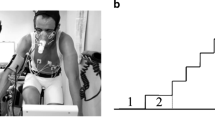Abstract
Muscular power depends on the rate of the exergonic reactions taking place in the muscles during activity. These are essentially a) splitting of the high energy phosphate compounds (phosphagen), b) glycolysis and lactic acid formation, and c) oxidative reactions; b) and c) are used to rebuild the phosphagen broken down as from a).
The rate of reaction a) is sensibly constant during the first 6–8 secs of work at maximum rate, then declining with the exhaustion of phosphagen. By measuring the maximal rate of work in an exercise such as running up a staircase for 1–2 secs only (4–8 steps), the maximal anaerobic power can be measured: this is done by measuring the time of performance with a timer sensitive to 0.01 secs, and by knowing the height of the step. The test is fast and easy and well accepted by the subject as the time of performance is too short to lead to exhaustion. Thisanaerobic power is ab 3 times theaerobic power.
Theaerobic power is measured by stepping up and down at two fixed submaximal rates and by measuring the heart rates (f1 and f2): from this, by means of a formula or a nomogram, the maximal O2 consumption, or the aerobic power, is calculated.
Both the aerobic and the anaerobic power tests involve familiar exercises that do not require training, or calibration of apparatuses, or excessive stress on the subjects.
A convenient representation of the main circulatory and respiratory changes (\(\dot VO_2 ^{\max } ,\dot VA^{\max } \), heart frequency and stroke volume.\(\dot VA/Q\), Hb, and others) taking place in muscular exercise at sea level and at altitude is also given.
Similar content being viewed by others
References
Margaria, R., P. Aghemo, andE. Rovelli: J. appl. Physiol.20, 1070 (1965).
—, andP. Cerretelli: Biometeorology, ed. byS. W. Tromp, p 3. Oxford: Pergamon Press 1962.
— —,P. Aghemo, andG. Sassi: J. appl. Physiol.18, 367 (1963).
— —,P. E. di Prampero, C. Massari, andG. Torelli: J. appl. Physiol.18, 371 (1963).
— — andF. Mangili: J. appl. Physiol.19, 623 (1964).
—,H. T. Edwards, andD. B. Dill: Amer. J. Physiol.106, 689 (1933).
Author information
Authors and Affiliations
Additional information
This paper was read on Sept. 17th, 1965 in Kyoto, Japan at the International Symposium on Environmental Physiology, promoted by the International Biological Programme, and supported by IUPS, FASEB and HA Section of J.I.B.P.
Rights and permissions
About this article
Cite this article
Margaria, R. Assessment of physical activity in oxidative and anaerobic maximal exercise. Int. Z. Angew. Physiol. Einschl. Arbeitsphysiol. 22, 115–124 (1966). https://doi.org/10.1007/BF00698146
Received:
Issue Date:
DOI: https://doi.org/10.1007/BF00698146




